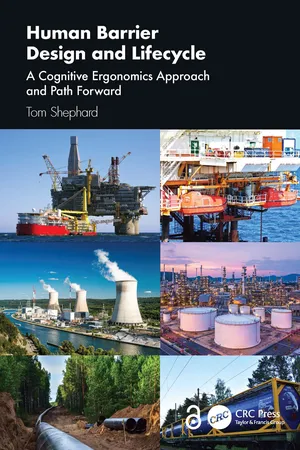
Human Barrier Design and Lifecycle
A Cognitive Ergonomics Approach and Path Forward
- 654 pages
- English
- ePUB (mobile friendly)
- Available on iOS & Android
About this book
A common source of failure in a human?dependent barrier or safety critical task is a designed?in mismatch error. The mismatch is a cognitive demand that exceeds the human capability to reliably and promptly respond to that demand given the plausible situations at that moment. Demand situations often include incomplete information, increased time pressures, and challenging environments. This book presents innovative solutions to reveal, prevent, and mitigate these and many other cognitive?type errors in barriers and safety critical tasks. The comprehensive model and methodologies also provide insight into where and to what extent these barriers and task types may be significantly underspecified and the potential consequences.
This title presents a new and comprehensive prototype design and lifecycle model specific to human?dependent barriers and safety critical tasks. Designed to supplement current practice, the model is fully underpinned by cognitive ergonomics and cognitive science. The book also presents a compelling case for why a new global consensus standard specific to human?dependent barriers is needed. Taking a novel approach, it presents its suggested basis, framing, and content. Both solutions seek to redress deficiencies in global regulations, standards, and practice. The model is guided by industry recommendations and best practice guidance and solutions from globally recognized experts. Its processes are fully explained and supported by examples, analysis, and well?researched background materials. Real?life case studies from offshore oil and gas, chemical manufacturing, transmission pipelines, and product storage provide further insight into how overt and latent design errors contributed to barrier degradation and failure and the consequence of those errors.
An essential and fascinating read for professionals, Human Barrier Design and Lifecycle: A Cognitive Ergonomics Approach and Path Forward will appeal to those in the fields of human factors, process and technical safety, functional safety, display and safety system design, risk management, facility engineering, and facility operations and maintenance.
Chapters 1 and 8 of this book are freely available as downloadable Open Access PDFs at http://www.taylorfrancis.com under a Creative Commons Attribution-Non Commercial-No Derivatives (CC-BYNC-ND) 4.0 International license.
Frequently asked questions
- Essential is ideal for learners and professionals who enjoy exploring a wide range of subjects. Access the Essential Library with 800,000+ trusted titles and best-sellers across business, personal growth, and the humanities. Includes unlimited reading time and Standard Read Aloud voice.
- Complete: Perfect for advanced learners and researchers needing full, unrestricted access. Unlock 1.4M+ books across hundreds of subjects, including academic and specialized titles. The Complete Plan also includes advanced features like Premium Read Aloud and Research Assistant.
Please note we cannot support devices running on iOS 13 and Android 7 or earlier. Learn more about using the app.
Information
Table of contents
- Cover
- Half Title
- Title Page
- Copyright Page
- Table of Contents
- About the Author
- Permissions
- Acknowledgments
- Chapter 1 Introduction
- Chapter 2 Terms, Definitions, and Model Constructs
- Chapter 3 Conceptual and Preliminary Design (Model Phases A and B)
- Chapter 4 Detailed Design, Engineering, and Requisitions (Model Phase C)
- Chapter 5 Implementation: Procurement, Fabrication, Human and Organizational Elements (Model Phase C)
- Chapter 6 Construction, Installation, and Commissioning (Model Phase D)
- Chapter 7 Operate and Maintain, Modify, and Decommission (Model Phases E, F, and G)
- Chapter 8 The Case for Developing a New Standard for Active Human Barriers
- Chapter 9 Concluding Observations, Findings, and Remarks
- Appendix A – Project Execution and Planning
- Appendix B – Technical Design, Resources, and Topics
- Appendix C – Teams and Teamworking
- Appendix D – Performance Standards
- Appendix E – Procurement
- Appendix F – Cognition: Baseline Science and Application
- Appendix G – Verification and Validation
- Appendix H – Performance Influencing Factors
- Appendix I – Cognitive Assessment and Mitigation Process
- Appendix J – Human and Organizational Elements
- Appendix K – Workspace Development and Design
- Appendix L – Remote Barrier Support, Remote Operations Centers
- Appendix M – Deepwater Horizon Accident: Active Barrier Causal Contributors
- References
- Index